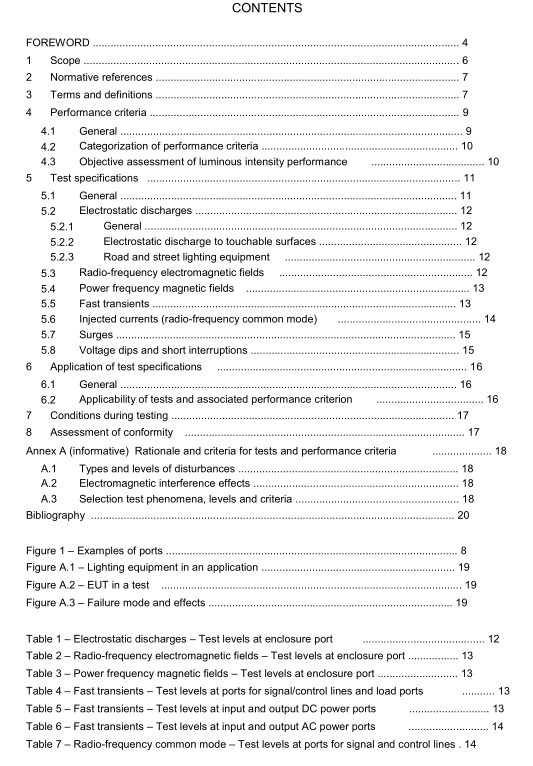IEC 61547 pdf – Equipment for general lighting purposes – EMC immunity requirements

IEC 61547 pdf – Equipment for general lighting purposes – EMC immunity requirements
For these functions,three different levels of performance criteria are specified in 4.2. Thefunctions assessed and the performance criteria for each individual test shall be noted in thetest report.
The effects of electromagnetic disturbances on the life of the equipment under test areexcluded from this document.
4.2Categorization of performance criteria
The following three categories of performance criteria apply.a)Performance criterion A
During the test,no change of the luminous intensity shall be observed and the regulatingcontrol, if any, shall operate during the test as intended.
b)Performance criterion B
During the test, the luminous intensity may change to any value. After the test,theluminous intensity shall be restored to its initial value within 1 min (30 min for highpressure gas discharge lamps).Regulating controls need not function during the test,butafter the test,the mode of the control shall be the same as before the test,provided thatduring the test no mode changing commands were given.
c) Performance criterion c
During and after the test,any change of the luminous intensity is allowed and the lightsource(s) may be extinguished. After the test,within 30 min,all functions shall return tonormal,if necessary by temporary interruption of the mains supply and/or operating theregulating control.
The following additional requirement applies to lighting equipment incorporating_ a startingdevice: after the test, the lighting equipment is switched off for 30 min and back on again.The
lighting equipment shall start and operate as intended.
The application of the different performance criteria for the various types of tests and fordifferent lighting equipment are specified in Clause 6.
4.3Objective assessment of luminous intensity performance
A change of luminous intensity shall be checked by either one of the following requirements:. no change of luminous intensity by visual observation, or
– the luminous intensity of a lighting equipment by measurement.
When being measured,the luminous intensity of lighting equipment shall be measured bymeans of an illuminance (lux) meter which is positioned in an axis perpendicular to the mainplane of the lighting equipment, in its centre and at a distance for proper operation of the luxmeter. The luminous intensity shall be deemed to be unchanged if the measured intensitiesduring and after the test do not deviate by more than 15 %. in stand-by mode the change ofthe luminous intensity shall be less than 5 % of the maximum luminous intensity (100 % lightoutput).
Care shall be taken to ensure the ambient light level does not influence the measurementresults.
Precautions to achieve reproducible results given in the relevant light source performancestandards shall be observed.
5 Test specifications
General
5.1 Immunity requirements for lighting equipment are specified in 5.2 to 5.8 on a port by port basis for the following disturbances:
– electrostatic discharges;
– continuous and transient disturbances;
– radiated and conducted disturbances;
– mains supply-related disturbances.
Tests are applied to the relevant ports of the equipment as indicated in the respective clauses. For the purposes of this document, DC power ports for supplying regulating controls are considered to be signal ports. Tests shall be conducted in a well-defined and reproducible manner. Tests shall be carried out as single tests in sequence. The sequence of testing is optional. It may be determined from consideration of the electrical characteristics and usage of particular equipment that some of the tests are inappropriate and therefore unnecessary. In such cases it is required that the decision not to test be recorded in the test report. The description of the test, the test generator, the test methods and the test set-up are given in the basic standards, which are referred to in the relevant clauses.
In this document, in most cases, the selected test levels are based on level 2 values as given in the basic test and measurement immunity standards; these standards are referred to in the respective clauses. Further explanation on the methodology and criteria why certain test phenomena, test levels and performance criteria are chosen for certain types of lighting equipment are given in Annex A. Modules are tested as any other lighting equipment but shall be mounted in a representative host and the port(s) of the module being assessed shall be terminated accordingly.
A representative host is a reference luminaire or reference system that enables proper functioning of the EUT. The functions of the host that are specific to the module being assessed shall be exercised during the tests. The host shall also incorporate essential EMI protection means or mitigation measures if these are explicitly specified by the manufacturer for application of such a module. A representative host shall also include the safety Class I or II features, whichever is applicable. If the module is tested in a host, the correct functioning of the combination shall be verified prior to the application of the disturbance. A detailed description of the host shall be given in the test report. Self-ballasted lamps shall be tested in hosts (reference luminaires) as specified in CISPR 15:2018, Annex A.









